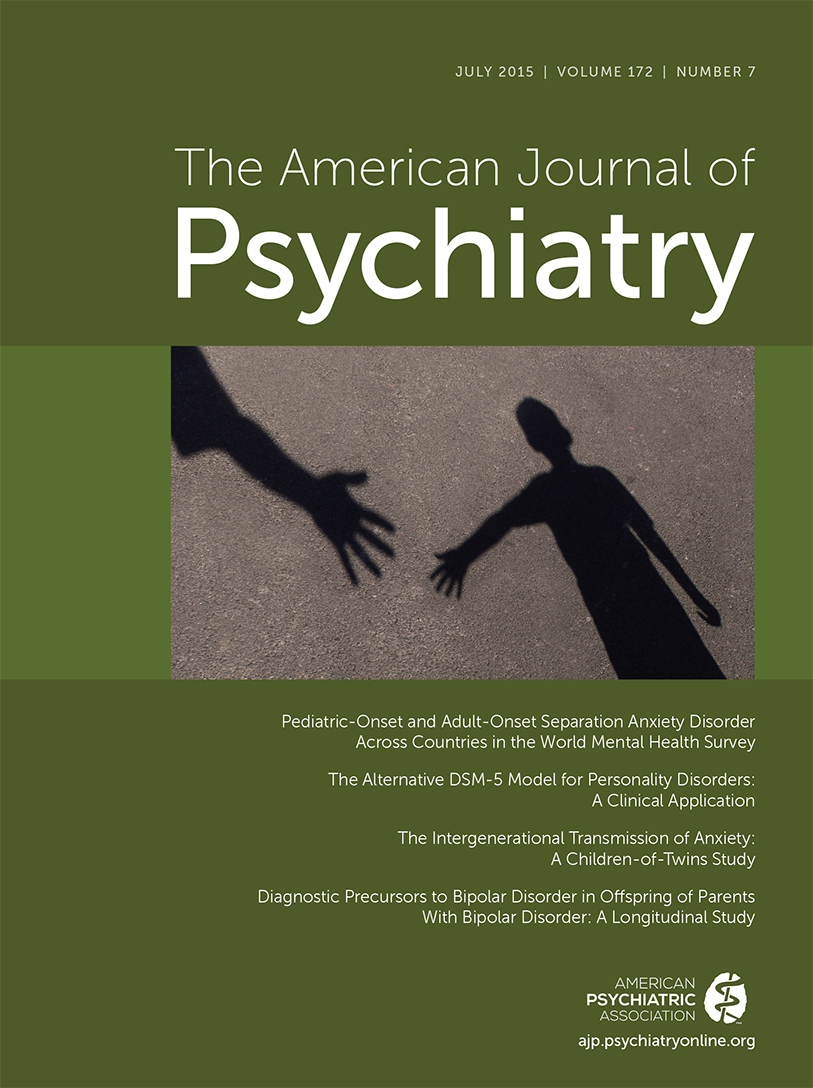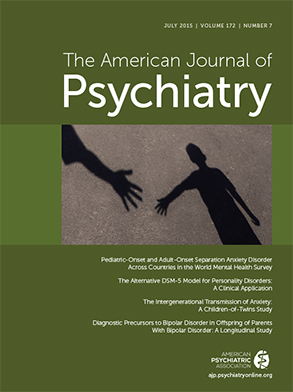Anxiety disorders are the most common psychiatric disorders across the lifespan, affecting over 25% of people at some time in their lives (
1). They cause substantial difficulties in social, family, educational, or occupational domains and present a risk for other serious disorders, such as depression and substance abuse. The combination of high prevalence, pervasive impairment, and a high degree of persistence and comorbidity means that anxiety disorders have a greater economic burden than any other mental health disorder (
2,
3). Understanding the development of anxiety disorders in children and adolescents and later into adulthood is critical to inform prevention and treatment efforts.
Anxiety disorders have an earlier onset than most other mental health disorders, with a median age at onset of 11 years, and over one-half of adults with an anxiety disorder will have met diagnostic criteria in their youth (
1). Much research into the development of anxiety disorders has been directed by the finding that they commonly run in families (
4). Although both genetic and environmental routes to intergenerational transmission have been implicated, studies examining their relative contribution have typically used a twin-pair design that allows for examination of similarities and differences between sibling pairs but cannot provide information on how or when anxiety symptoms or disorders are transmitted. The study described by Thalia C. Eley, Ph.D., et al. (
5), in this issue of the
Journal, is applauded for its use of a genetically and developmentally sensitive children-of-twins design in which adult twin pairs (387 monozygotic and 489 dizygotic), their spouses, and adolescent offspring completed measures of anxious personality or symptoms (and neuroticism among a subset). Consistent with previous findings, Eley et al. found evidence to support genetic influences on anxious personality among adults on the basis that associations were higher among monozygotic adult twin pairs than dizygotic pairs. However, genetic effects on the
transmission of anxiety were small, and a model reflecting only environmental transmission was the best fit for the data. In other words, anxiety has been passed from parent to adolescent offspring through learning experiences rather than through genetic risk.
Developmental Dynamic Effects
While it may seem counterintuitive that twin-pair associations supported significant genetic associations yet there was little support for a genetic path of intergenerational transmission, one potential explanation for these apparently discrepant findings is genetic innovation, in which different genes are associated with the expression of particular characteristics at different stages in development. For example, in a four-wave longitudinal twin study that assessed participants from age 8 up to age 10, Kendler et al. (
6,
7) found that new sets of genetic risk factors associated with fear intensity and anxiety and depression symptoms become active, and others decline in influence, as children move from late childhood into early adolescence, late adolescence, and early adulthood. To fully evaluate this possibility in relation to the intergenerational transmission of anxiety will require a combination of the children-of-twins design and a prospective approach as used by the other teams reporting in this issue on the development in adolescents of bipolar disorder and irritability. In combination, these methods will have the scope to examine differences in monozygotic/dizygotic associations between family members’ anxiety levels when they were at equivalent ages (i.e., the anxiety level of the parents when they were adolescents themselves). This approach holds great promise, and fortunately there are now large longitudinal twin studies that have retained good samples as the twins reach adulthood and begin to have their own children (
8), making these sorts of evaluations a realistic possibility in the near future.
The findings by Eley et al. are entirely consistent with models of the intergenerational transmission of affective disorder that suggest that living with a parent with an affective disorder does not only entail a genetic risk but may also increase exposure to potential environmental risk factors (
9,
10). Eley et al. note a number of potential environmental mechanisms for the intergenerational transmission of anxiety, in particular parental modeling of anxious responses and negative parenting behaviors (such as overcontrol and rejection). These parental behaviors are hypothesized to promote anxiety among children and young people, especially among those who already experience elevated trait anxiety (
11). There is some (albeit inconsistent) support for associations between each of these parenting dimensions and child anxiety, and in some cases (e.g., modeling) these same behaviors have been associated with the presence of parental anxiety disorders (
12,
13).
Unlike the Eley et al. study, most studies of parent-child interactions in the context of child anxiety have focused on preadolescent children or included broad age ranges covering childhood and adolescence without taking age into account. This has seriously limited our understanding by failing to consider the substantial normative shifts in parent-offspring interactions that occur as offspring move into adolescence. As will be familiar to many parents, these include increases in the intensity of conflict and decreases in affectionate behaviors. It is not surprising then that where associations between parental behaviors and offspring anxiety disorder status have been compared between children and adolescents, the nature of the association differs significantly. Specifically, parents of adolescents with anxiety disorders exhibit more intrusiveness and lower warm engagement than parents of nonanxious adolescents; however, the reverse pattern is found among children (
14). As is true for the Eley et al. study, prospective examination is required to test this proposition, as well as to consider reciprocal relationships between child and parent responses in which anxious children could kindle their parents’ anxiety. Nonetheless, these findings are certainly consistent with the notion that, just as particular genes become active/inactive in their influence on anxiety through development, so do different environmental (and specifically parental) influences.
The study by Eley et al. is emblematic of the application of increasingly sophisticated designs that allow for the identification of complex developmental differences in mechanisms of the intergenerational transmission of anxiety, providing critical information to guide more nuanced approaches to prevention and treatment. As those children who have been recruited in twin studies move into adulthood and have their own children, the possibilities for improving understanding will grow exponentially, including the ability to examine the interactive effects of genes and environment through development. These findings and the work that will inevitably follow highlight the need to preserve large twin studies such as this, which hold promise to push forward theoretical and clinical advances as new generations come on board.

